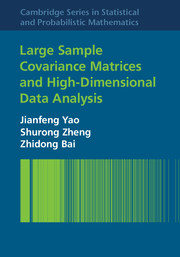Refine search
Actions for selected content:
48274 results in Computer Science
Dedication
-
- Book:
- Random Wireless Networks
- Published online:
- 05 May 2015
- Print publication:
- 13 April 2015, pp iii-iv
-
- Chapter
- Export citation
REC volume 27 issue 2 Cover and Back matter
-
- Article
-
- You have access
- Export citation
9 - Throughput Capacity
-
- Book:
- Random Wireless Networks
- Published online:
- 05 May 2015
- Print publication:
- 13 April 2015, pp 202-228
-
- Chapter
- Export citation
NWS volume 3 issue 1 Cover and Front matter
-
- Journal:
- Network Science / Volume 3 / Issue 1 / March 2015
- Published online by Cambridge University Press:
- 09 April 2015, pp. f1-f3
-
- Article
-
- You have access
- Export citation
NWS volume 3 issue 1 Cover and Back matter
-
- Journal:
- Network Science / Volume 3 / Issue 1 / March 2015
- Published online by Cambridge University Press:
- 09 April 2015, pp. b1-b3
-
- Article
-
- You have access
- Export citation
Examining the literature on “Networks in Space and in Time.” An introduction
-
- Journal:
- Network Science / Volume 3 / Issue 1 / March 2015
- Published online by Cambridge University Press:
- 09 April 2015, pp. 1-17
-
- Article
- Export citation
Equational axioms associated with finite automata for fixed point operations in cartesian categories
-
- Journal:
- Mathematical Structures in Computer Science / Volume 27 / Issue 1 / January 2017
- Published online by Cambridge University Press:
- 08 April 2015, pp. 54-69
-
- Article
- Export citation
INFINITARY TABLEAU FOR SEMANTIC TRUTH
-
- Journal:
- The Review of Symbolic Logic / Volume 8 / Issue 2 / June 2015
- Published online by Cambridge University Press:
- 08 April 2015, pp. 207-235
- Print publication:
- June 2015
-
- Article
- Export citation

Large Sample Covariance Matrices and High-Dimensional Data Analysis
-
- Published online:
- 05 April 2015
- Print publication:
- 26 March 2015
-
- Book
- Export citation
BIBLIOGRAPHY
-
- Book:
- Pure Inductive Logic
- Published online:
- 05 May 2015
- Print publication:
- 02 April 2015, pp 327-336
-
- Chapter
- Export citation
Chapter 22 - Principles of Analogy
- from Part 2 - Unary Pure Inductive Logic
-
- Book:
- Pure Inductive Logic
- Published online:
- 05 May 2015
- Print publication:
- 02 April 2015, pp 165-170
-
- Chapter
- Export citation
Chapter 43 - Less Well Travelled Roads
- from Part 3 - Polyadic Pure Inductive Logic
-
- Book:
- Pure Inductive Logic
- Published online:
- 05 May 2015
- Print publication:
- 02 April 2015, pp 323-326
-
- Chapter
- Export citation
Chapter 24 - Introduction to Polyadic Pure Inductive Logic
- from Part 3 - Polyadic Pure Inductive Logic
-
- Book:
- Pure Inductive Logic
- Published online:
- 05 May 2015
- Print publication:
- 02 April 2015, pp 181-182
-
- Chapter
- Export citation
Chapter 40 - Similarity
- from Part 3 - Polyadic Pure Inductive Logic
-
- Book:
- Pure Inductive Logic
- Published online:
- 05 May 2015
- Print publication:
- 02 April 2015, pp 303-310
-
- Chapter
- Export citation
Chapter 19 - The NP-Continuum
- from Part 2 - Unary Pure Inductive Logic
-
- Book:
- Pure Inductive Logic
- Published online:
- 05 May 2015
- Print publication:
- 02 April 2015, pp 135-142
-
- Chapter
- Export citation
Chapter 5 - The Dutch Book Argument
- from Part 1 - The Basics
-
- Book:
- Pure Inductive Logic
- Published online:
- 05 May 2015
- Print publication:
- 02 April 2015, pp 25-32
-
- Chapter
- Export citation
Chapter 10 - Regularity and Universal Certainty
- from Part 2 - Unary Pure Inductive Logic
-
- Book:
- Pure Inductive Logic
- Published online:
- 05 May 2015
- Print publication:
- 02 April 2015, pp 61-68
-
- Chapter
- Export citation
Chapter 11 - Relevance
- from Part 2 - Unary Pure Inductive Logic
-
- Book:
- Pure Inductive Logic
- Published online:
- 05 May 2015
- Print publication:
- 02 April 2015, pp 69-72
-
- Chapter
- Export citation


